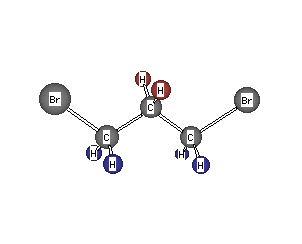Formula: C3H6Br2
Answer: 1,3-Dibromopropane
Chemical Shift Assignments: δ 2.37 (pentuplet,, 2H), 3.58 (triplet, 4H)
The formula indicates no degrees of unsaturation. The integration must be doubled to accommodate the six hydrogens of the formula. The signal at δ 3.58 is the lower field absorption which must be 2 x -CH2Br to satisfy the integration. All that remains is -CH2- to connect the two fragments. The high field methylene group at δ 2.37 produces triplets for δ 3.58 and, conversely, the four hydrogens at δ 3.58 cause δ 2.37 to be a pentuplet.
The 13C NMR spectrum reveals only two singlets: 34.7 and 31.4 ppm. The latter signal appears to be more intense than the former. The temptation is to assign 31.4 ppm to the -CH2Br and 34.7 ppm to -CH2-. The 13C spectrum of 1,3-dichloropropane has signals at 41.5 and 35.0 ppm, wherein the signal at 41.5 ppm is the larger of the two. In the two spectra, the 34.7 and 35.0 ppm values are almost identical and the difference between -CH2Cl and -CH2Br is 10.1 ppm. The difference in chemical shift between the equivalent carbons in CH3CH2CH2Br ( 35.7 ppm) and CH3CH2CH2Cl (46.9 ppm) is 11.2 ppm. Thus, it is reasonable to assign 34.7 ppm to -CH2- and 31.4 ppm to -CH2Br. Return to Menu.
 |
bromine=violet |
|---|